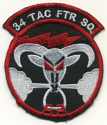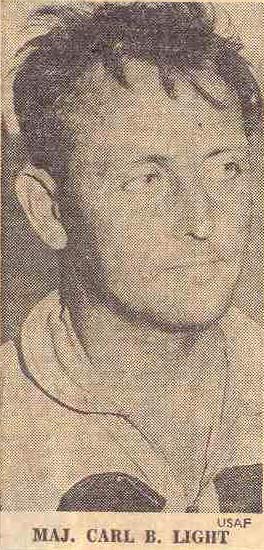34th Tactical Fighter Squadron - Thud Era
Korat RTAFB, Thailand - May 1966 to May 1969

Press Raids On SAM Sites
Heavy North Vietnamese antiaircraft fire downed two U.S. Air Force fighter-bombers just above the Demilitarized Zone and raised the total of American warplanes lost in combat over North Vietnam to 850, the U.S. Command announced Sunday.
The three crewmen were rescued. One of them, Maj. Carl B. Light, 36, “layed low” through the night to evade North Vietnamese troops after heavy antiaircraft fire drove rescue aircraft away.
He was recovered by a “Jolly Green Giant” rescue copter at 2:25 p.m. Sunday after 21 hours and 45 minutes on the soil of North Vietnam.
Light was taken to a hospital in Da Nang where he was reported resting comfortably and in good condition.
The Air Force retaliated with massive strikes on the antiaircraft sites and surface-to-air missiles (SAMs), SAM equipment and control vans, launchers and transports just inside North Vietnam in the area 10 to 20 miles above the Demilitarized Zone.
A U.S. military spokesman said the Air Force had “increased its targeting” on North Vietnam’s beefed up air defenses just above the DMZ, meaning the fighter bombers shifted the thrusts of their attacks from enemy supply routes to the antiaircraft sites and SAMs.
Air Force pilots reported destroying or damaging 13 antiaircraft sites and three SAMs and three SAM equipment and control vans in raids Saturday.
The raids on the North Vietnamese air defense system highlighted 134 missions flown by Air force, Navy, and Marine pilots Saturday in the southern panhandle.
Light’s F-105 Thunderchief fighter-bomber was downed late Saturday afternoon 10 miles north of the Demilitarized Zone and six miles inland from the coast.
Wednesday, July 3, 1968: Pilot Saved in “Hopeless” Rescue Attempt
Da Nang, Vietnam (Special) --
“I thought that the best that I could get out of this deal was to be captured. I didn’t see any way for a helicopter to get in there and get me out.”
That is how Maj. Carl B. Light, 36, Beaumont, Tex., described his thoughts after ejecting from his damaged F-105 Thunderchief in North Vietnam recently. The fighter pilot, assigned to the 388th Tactical Fighter Wing, was rescued by members of the 37th Aerospace Rescue and Recovery Sq. after spending nearly 24 hours in enemy territory.
The rescue effort was carried out despite heavy North Vietnamese fire. It involved 58 tactical fighter strikes, five HH-3E Jolly Green Giant rescue helicopters, seven A1E Skyraiders and a command aircraft.
Light was downed after making a successful fighter strike in the southern panhandle of North Vietnam against a surface-to-air missile (SAM) site.
“I was making a rocket pass on some trucks when I felt something hit in the aft section of the airplane. The aircraft caught on fire and I had fire warning lights immediately,” Light reported. “The aircraft then started making a right-hand roll that became uncontrollable and the plane started to go upside down. That’s when I knew that I was not going to be able to stay with it.”
The pilot ejected without injury, but was unaware of his descent to the ground.
“The next thing that I remember was lying in a rice paddy attached to my survival kit and there were 37mm and 57mm automatic weapons all around me—a lot of them,” the Air Force pilot commented.
After disconnecting himself from his parachute, Light started looking for a hiding place. “I got into a bush and covered up as best I could,” he said. Light then used his survival radio to contact the forward air controller (FAC) in the area to tell him that he was all right on the ground.
“The F-100 Supersabre FAC told me that they were going to suppress the gun sites and get me out. I wasn’t convinced, but the fighters in the area did come in. They were unable to knock them out so I said that I would try to move south so that I could get away from the gun sites,” Light said.
As darkness neared, the fighters left the area and the downed pilot started moving south. No helicopter rescue was attempted because no helicopter could have survived in that heavy-fire area. He stopped crawling in an open rolling terrain with low bushes.
“I thought that I was pretty well away from the guns until 5:30 in the morning. I had positioned myself inside a bush and then I saw another gun open up about 400 yards away from me,” Light said. “I think the North Vietnamese were looking for me, but not very hard. They wanted to use me for bait and possibly get another airplane.”
About 9:00 a.m., about 17 hours after ejection, Light saw an F-100 fly over. He contacted him on the radio and told him that he was still all right. The pilot again assured Light that they would get him out.
Fighter strikes then were called in over the enemy gun sites.
Light reported, “Throughout the day the fighters did a tremendous job of suppressing the guns. They put in a terrific amount of ordnance to get me out. When they had the guns sufficiently calmed down, the helicopters and A1Es moved in. The Jolly Green Giant then snatched me out of there,” Light stated. “It was a great feeling to see those guys and when they got me in the chopper, I said, ‘You guys do good work.’ Those choppers were running a very high risk of getting shot down themselves when they came in and picked me up.”
